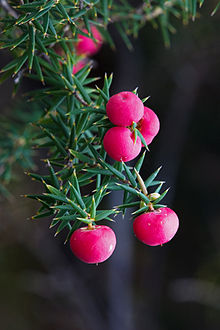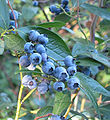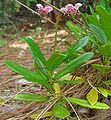- Ericaceae
-
Ericaceae 
Leptecophylla juniperina Scientific classification Kingdom: Plantae (unranked): Angiosperms (unranked): Eudicots (unranked): Asterids Order: Ericales Family: Ericaceae
Juss.Type genus Erica
L.Subfamilies - Enkianthoideae
- Pyroloideae
- Monotropoideae
- Arbutoideae
- Cassiopoideae
- Ericoideae
- Harrimanelloideae
- Styphelioideae
- Vaccinioideae
Diversity 126 genera with c. 4000 species The Ericaceae, commonly known as the heath or heather family, is a group of mostly calcifuge plants (lime-hating). The family is large, with roughly 4000 species spread across 126 genera, making it the 14th most speciose family of flowering plants.[1]
There are many well-known and economically important members of the Ericaceae, these include the cranberry, blueberry, huckleberry, azalea, rhododendron, and various common heaths and heathers (Erica, Cassiope, Daboecia, and Calluna for example).[2]
Contents
Etymology
The name Ericaceae comes from the type genus Erica, which appears derived from the Greek word "ereike". The exact meaning is difficult to interpret, but some sources show it as simply meaning "heather".[3] The name may have been used informally to refer to the plants in pre-Linnaean times, and was simply formalised when Linnaeus described Erica in 1753, and then when Jussieu described the Ericaceae in 1789.[4]
Distribution
Ericads have a nearly worldwide distribution. They are absent from continental Antarctica, parts of the high Arctic, central Greenland, northern and central Australia, and much of the lowland tropics and neotropics.[1]
Taxonomy
In 2002 research conducted by Kron et al.[5] resulted in the inclusion of the formerly recognised families Empetraceae, Epacridaceae, Monotropaceae, Prionotaceae and Pyrolaceae into the Ericaceae. This was based on a combination of molecular, morphological, anatomical, and embryological data. The move significantly increased the morphological and geographical range found within the group. The resulting family now includes nine subfamilies:
- Enkianthoideae Kron, Judd & Anderberg (1 genus, 16 species)
- Pyroloideae Kosteltsky (4 genera, 40 species)
- Monotropoideae Arnott (10 genera, 15 species)
- Arbutoideae Niedenzu (5 genera, 80 species)
- Cassiopoideae Kron & Judd (1 genus, 12 species)
- Ericoideae Link (19 genera, 1790 species)
- Harrimanelloideae Kron & Judd (1 genus, 2 species)
- Styphelioideae Sweet (35 genera, 545 species)
- Vaccinioideae Arnott (50 genera, 1580 species)
Characteristics
The Ericaceae contains a morphologically diverse range of taxa, including herbs, dwarf shrubs, shrubs and trees. The leaves are usually alternate or whorled, simple and without stipules, and hermaphrodite flowers. The flowers show considerable variability. The petals are often fused (sympetalous) with shapes ranging from narrowly tubular to funnelform or widely bowl-shaped. The corollas are usually radially symmetrical (actinomorphic) but many flowers of the genus Rhododendron are somewhat bilaterally symmetrical (zygomorphic).[6]
Ecology
The family is largely made up of calcifuge plants, that tend to thrive only in acidic soils. This is a trait not found in the Clethraceae and Cyrillaceae, the two families most closely related to the Ericaceae.
Most Ericaceae (excluding the Monotropoideae, Pyroloideae, and some Styphelioideae) form mycorrhizae, where fungi grow in and around the roots and provide the plant with nutrients. This symbiotic relationship is considered crucial to the success of members of the family in edaphically stressful environments worldwide.[7] The Pyroleae tribe are mixotrophic and gain sugars from the mycorrhizae as well as nutrients.[8]
In many parts of the world, a "heath" or "heathland" is an environment characterised by an open dwarf-shrub community found on low quality acidic soils, generally dominated by plants in the Ericaceae. In eastern North America, members of this family often grow in association with an oak canopy, in a type of ecology known as an oak-heath forest. [9][10]
Genera
See the full list at List of Ericaceae genera.
Image Gallery
-
Mountain laurel (Kalmia latifolia), showing radially symmetrical flower.
-
Vaccinium (Ericaceae) berries, from top right:
-
thumb|Chimaphila menziesii
References
- ^ a b Stevens, P. F. (2001 onwards). Angiosperm Phylogeny Website. Version 9, June 2008. http://www.mobot.org/MOBOT/research/APweb/
- ^ Kathleen A. Kron, E. Ann Powell and J. L. Luteyn (2002). "Phylogenetic relationships within the blueberry tribe (Vaccinieae, Ericaceae) based on sequence data from MATK and nuclear ribosomal ITS regions, with comments on the placement of Satyria". American Journal of Botany 89 (2): 327–336. doi:10.3732/ajb.89.2.327. PMID 21669741. http://www.amjbot.org/cgi/content/full/89/2/327.
- ^ Wiktionary. 2011. Ericaceae. http://en.wiktionary.org/wiki/Ericaceae
- ^ Jussieu, A.-L. de. 1789. Genera plantarum ordines naturales disposita. pg. 159-160. Herissant & Barrois, Paris.
- ^ Kron, K.A., Judd, W.S., Stevens, P.F., Crayn, D.M., Anderberg, A.A., Gadek, P.A., Quinn, C.J., Luteyn, J.L. (2002). "Phylogenetic Classification of Ericaceae: Molecular and Morphological Evidence". The Botanical Review 68 (3): 335–423.
- ^ Watson, L., Dallwitz, M.J. (1992 onwards) The families of flowering plants: descriptions, illustrations, identification, and information retrieval. Version: 4th March 2011. http://delta-intkey.com.
- ^ Cairney, JWG & Meharg, AA (2003). "Ericoid mycorrhiza: a partnership that exploits harsh edaphic conditions". European Journal of Soil Science 54 (4): 735–740. doi:10.1046/j.1351-0754.2003.0555.x.
- ^ Liu, Z.; Wang, Z.; Zhou, J.; Peng, H. (2010). "Phylogeny of Pyroleae (Ericaceae): implications for character evolution". Journal of plant research 124 (3): 325–337. doi:10.1007/s10265-010-0376-8. PMID 20862511.
- ^ The Natural Communities of Virginia Classification of Ecological Community Groups (Version 2.3), Virginia Department of Conservation and Recreation, 2010
- ^ Schafale, M. P. and A. S. Weakley. 1990. Classification of the natural communities of North Carolina: third approximation. North Carolina Natural Heritage Program, North Carolina Division of Parks and Recreation.
External links
- Ericaceae at The Plant List
- Ericaceae, Epacridaceae, Empetraceae, Monotropaceae, and Pyrolaceae at The Families of Flowering Plants (DELTA)
- Ericaceae at the Encyclopedia of Life
- Ericaceae at the Angiosperm Phylogeny Website
- Ericaceae at the online Flora of North America
- Ericaceae at the online Flora of China
- Ericaceae at the online Flora of Pakistan
- Ericaceae at the online Flora of Chile
- Epacridaceae at the online Flora of New Zealand
- Epacridaceae at the online Flora of Western Australia
- Ericaceae at Ericaceae.org
- Ericaceae at the Australian Tropical Rainforest Plants Identification System
- Neotropical Ericaceae at the New York Botanical Garden
Categories:- Ericales families
- Ericaceae
Wikimedia Foundation. 2010.








